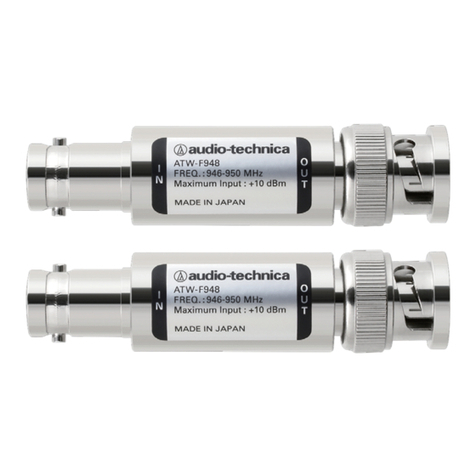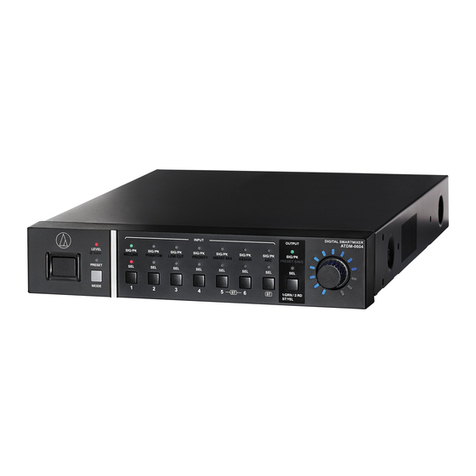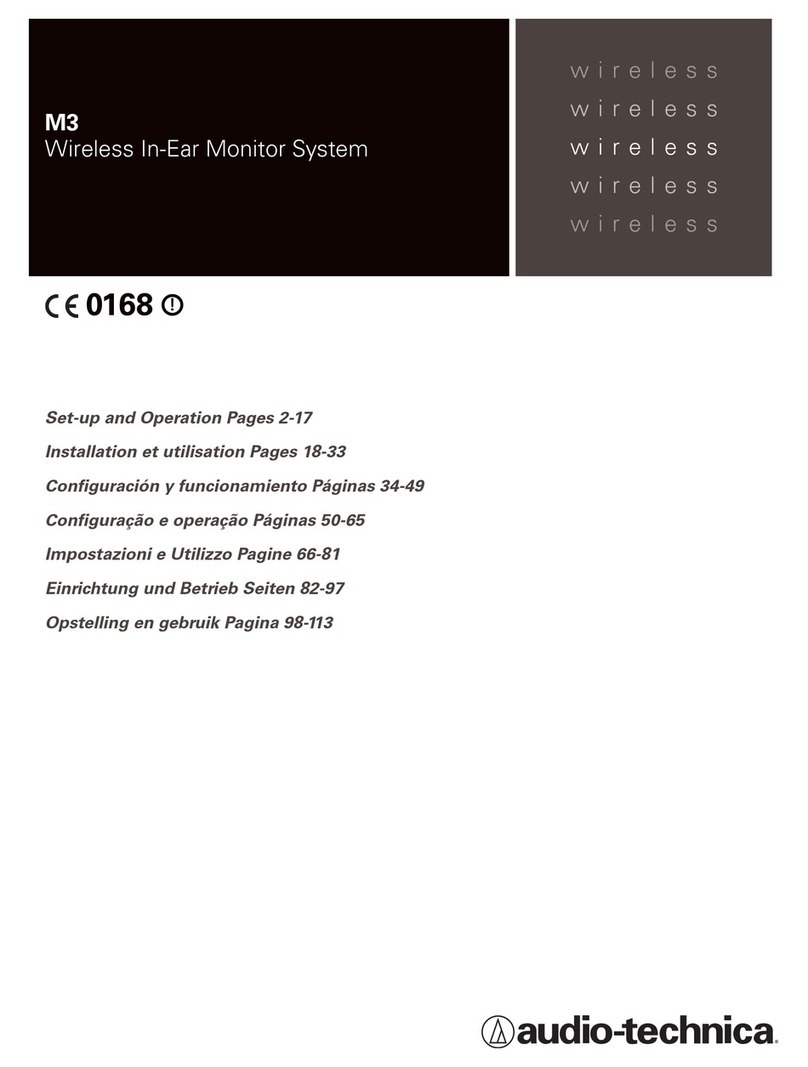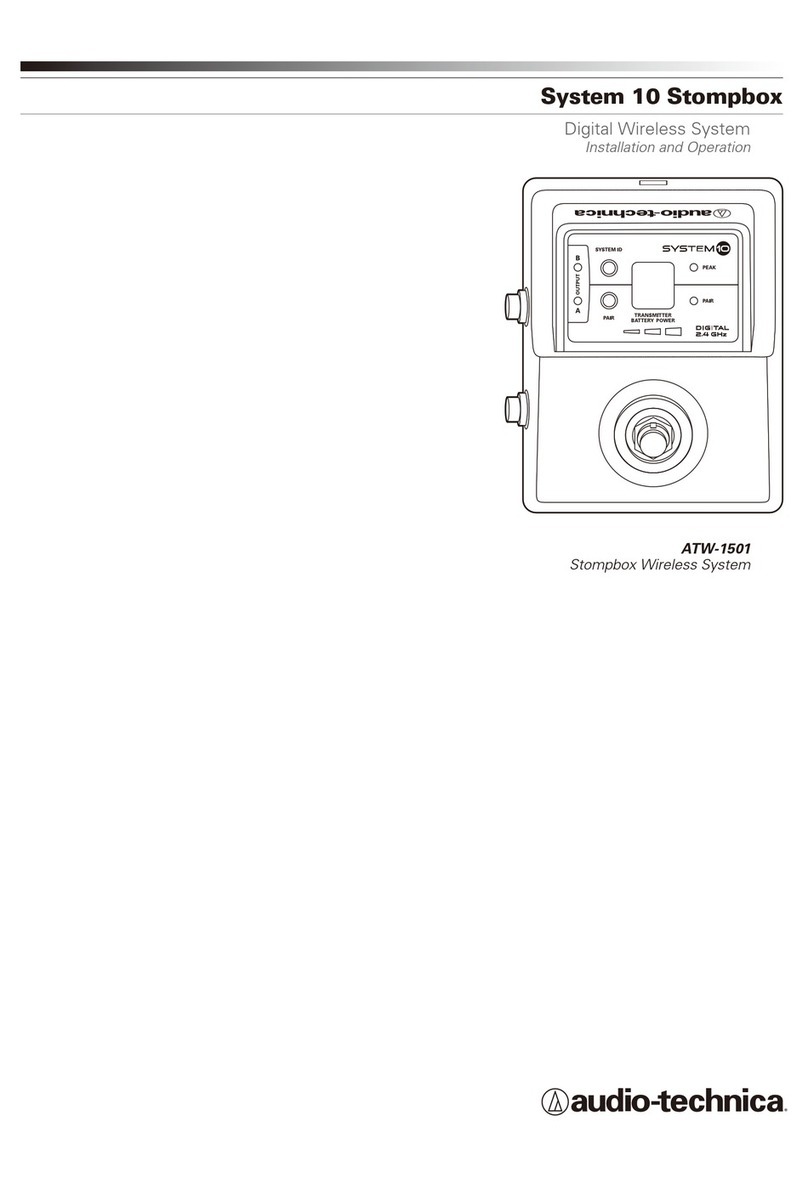Specications
OVERALL SYSTEM
Operating Frequency UHF 2 band
No.1 A1 ch 739.750 MHz, A2 ch 740.500 MHz
B1 ch 733.875 MHz, B2 ch 734.375 MHz
No.2 A1 ch 819.025 MHz, A2 ch 819.575 MHz
B1 ch 811.100 MHz, B2 ch 811.575 MHz
Frequency Stability ±0.005%, Crystal-controlled
Modulation Mode FM
Maximum Deviation Range ±10 kHz
Operation Range about 100m
(Under optimum condition)
Operation Temperature Range 4º C to 45º C
Frequency Response 100 Hz to 10 kHz
HANDHELD TRANSMITTER
Polar Pattern Unidirectional
RF Power Output * 20mW norminal
Spurious Emission * ETS 300 422
Microphone Element Dynamic Capsule
Battery 1.5V Type AA (LR6) alkaline X 2,
not included
Current Consumption 220 mA typical
Battery Life 6 ~ 8 hours
Dimensions 245.0 mm long,
38.0 mm body dia.
Net Weight (Without Battery) 215 grams
UNIPAK TRANSMITTER
RF Power Output * 20mW typ.
Spurious Emission * ETS 300 422
Input Connection High impedance, low impedance, bias
Battery 1.5V Type AA (LR6) alkaline X 2,
not included
Current Consumption 220 mA typical
Battery Life 6 ~ 8 hours
Dimensions 65.0 mm W x 110.0 mm H x 25.4 mm D
Net Weight (Without Battery) 95 grams
RECEIVER
Receiving System Dual independent receivers
Image Rejection ≥ 40 dB
Signal-to-noise Ratio * > 80 dB
Total Harmonic Distortion ≤ 1%
Sensitivity 10 µV for 60 dB S/N (IEC weighted)
Audio Output
Unbalanced: 360 mV
(at 1kHz,±10kHz deviation, 10kΩ load)
Balanced: 200 mV
(at 1kHz,±10kHz deviation, 10kΩ load)
Output Connectors Unbalanced: 6.3mm phone jack
Balanced: XLRM-type
Power Supply 12-18V DC, 500 mA, with provided AC
adapter
Dimensions 210.0 mm W x 49.0 mm H x 251 mm D
Weight 1.34 kgs
Accessories Included Two whip anntenas (can be bended)
* Carrier frequency, maximum deviation and output power depends on government regulations.
Notice to individuals with implanted cardiac pacemakers or AICD devicers:
Any source to RF (ratio frequency) energy may interfere with normal functioning of the implanted device. All wireless microphones have low-power transmitters (less than 0.05 watts output)
which are unlikely to cause difculty, especially if they are at least a few inches away. However, since a “body-pack” mic transmitter typically is placed against the body, we suggeat attaching
it at the belt, rather than in a shirt pocket where it may be immediately adjacent to the medical device. Note also that any medical-device disruption will cease when the RF transmitting
source is turned off. Please contact your physician or medical-device provider if you have any questions, or experience any problems with the use of this or any other RF equipment.
Audio Technica (Greater China) Limited
Unit K, 9/F., Kaiser Est. (Ph. 2),
51 Man Yue Street, Kowloon, HK.
http://www.audio-technica.com.hk
Nine Tips To Obtain The Best Results
1. Use only fresh alkaline batteries. Do not use “general purpose”
(carbon-zinc) batteries.
2. Position the receiver so that it has the fewest possible obstructions
between it and the normal location of the transmitter.
Line-of-sight is best.
3. The transmitter and the receiver should be as close together as
conveniently possible, but no closer together than one meter.
4. The receiver antennas should be in the open and away from any
metal.
5. The transmitter and receiver must be set to the same channel
number.
6. If the AF Level control of the receiver is set too high, it may
over-drive the input of the mixer or clip the output of the
receiver, causing distortion. Conversely, if the receiver output is
set too low, the overall signal-to-noise ratio of the system may be
reduced.
Adjust the output level of the receiver so the highest sound
pressure level going into the microphone causes no input overload
in the mixer, and yet permits the mixer level controls to operate in
their “normal“ range (not set too high or too low). This provides the
optimum signal-to-noise for the entire system.
7. You need to change channels 1) when a strong interference
signal is received, 2) when the channel breaks down, or 3) during
multiple-system operation in order to select an interference-free
channel.
8. In the UniPak transmitter, the “MT“ or “GT“ input control not in use
should be set to minimum.
9. Turn the transmitter off when not in use. Remove the battery if the
transmitter is not to be used for a period of time.
Audio-Technica (S.E.A.) Pte. Ltd.
623 Aljunied Road, #04-10,
Aljunied Industrial Complex, Singapore 389835
http://www.audio-technica.com.sg
Form No. ATGC-WM-002-03

































